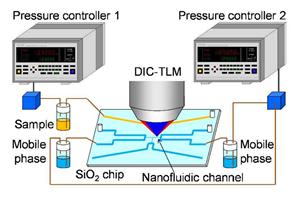The field of separation science has been continually evolving to enable the separation of smaller volumes. This interdisciplinary field has required developments in capillary electrophoresis, microfluidics and new detection technologies such as plasmonic sensing and thermal lensing.
Researchers from the Department of Applied Chemistry, University of Tokyo lead by Prof. Kitamori have shown the ability to perform femtolitre (1 x 10-15) separation and detection of nonfluorescent samples in a nanofluidic device. Using an extended nanofluidic device the researchers were able to separate and detect nonfluorescent molecules for the first time. Previous detection methodologies relied mainly on laser-induced fluorescence.
The researchers showed the ability of nanofluidic separation science combined with differential interference contrast thermal lens microscopy (DIC-TLM) to enable detection of 370 molecules in a 2.3 μm wide by 350 nm deep nanochannel with a separation efficiency of 150,000 plates/m. DIC-TLM is thermal lens microscopy with an increased detection limit by realising background-free photodetection using differential interference contrast.
Amazingly the injection volume and number of molecules were estimate to be 21 fL (1 x 10-15) and 250 zmol at the limit of detection. This limit of detection provides separation of a sample 8 orders of magnitude smaller that that possible with high-performance liquid chromatography. This injection volume is much smaller than a single cell and detection limit is similar to the number of typical protein molecules in a single cells. Providing a promising tool for single cell research.
To read more about this research download the HOT article which is free to access until April 5th
Femtoliter-Scale Separation and Sensitive Detection of Nonfluorescent Samples in an Extended-Nano Fluidic Device
Hisashi Shimizu, Kazuma Mawatari and Takehiko Kitamori
Analyst, 2014, Accepted Manuscript











